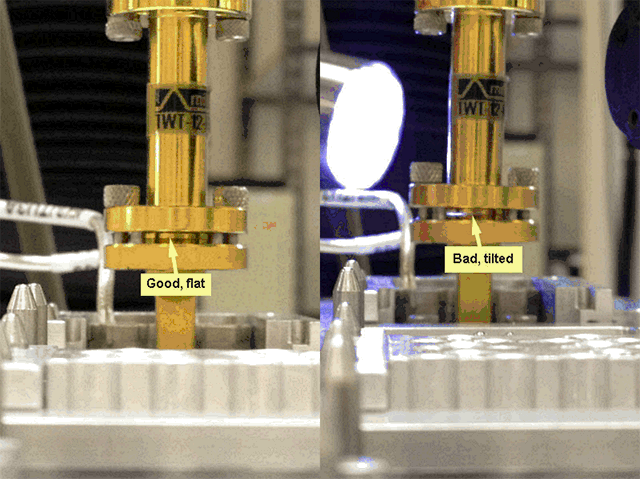When dealing with waveguide flanges, it’s crucial to note that the screws are located outside the waveguide projection. If not connected with care, the waveguide connection can tilt, leading to improper calibration. Therefore, it’s recommended to progressively tighten the screws to maintain the waveguide’s flatness.
Waveguide flanges, such as UG385, UG387, RR12, or RR15, often have a flat-to-flat or “boss-to-boss” design. This design can cause one screw to bind or get stuck if it’s tightened before the other, leaving the connection improperly clamped or “cocked”. This issue is particularly prevalent with the “short” standard, where the screws are longer as they sometimes have to pass through the shim. If one screw is tightened too far before the second one, it will definitely bind. However, the Cal plate block, being flat without a waveguide boss, partially mitigates this issue. Refer to Figure 1 Diagram and Figure 2 Picture for examples of properly and improperly connected waveguide flanges.
Figure 1: Diagram of Good/Bad Waveguide Connectors

To Reliably Tighten Waveguide Flanges:
- Tighten one screw about half way.
- Tighten the second screw until just snug.
- Come back and fully tighten the first screw.
- Fully tighten the second screw.
To Reliably Disconnect Waveguide Flanges:
- Loosen one screw about half way.
- Loosen the second screw until half way.
- Come back and fully loosen the first screw.
- Fully loosen the second screw.
To prevent the screws from binding, start both screws about halfway before fully tightening them. This process involves four insertions of the Allen driver. This is especially true for the screws on the short standard, as these screws are longer than standard ones to accommodate the added thickness when the shim (offset) is inserted. The same level of care is required when disconnecting the waveguide flanges. This technique is effective for both standard round "UG" waveguide flanges (UG385, UG387) and rectangular "RI" flanges (RR12, RR15).
For example, if it does not feel right when tightening the last screw, back them both off a 1/2 turn, then sneak up on the tightening; a little here, a little there, until it is right. It is real easy on the UG387 "boss" flanges to get the first screw a little too tight, which tilts the flange slightly. Then when tightening the second screw, it will feel tighter and tighter as it forces that side of the flange down. That's not good, so you have to do the back-off and sneak-up technique.
Figure 2: Picture of Good/Bad Waveguide Connectors

Figure 1 Image Source: https://www.microharmonics.com/interesting-facts-about-rectangular-waveguides/

